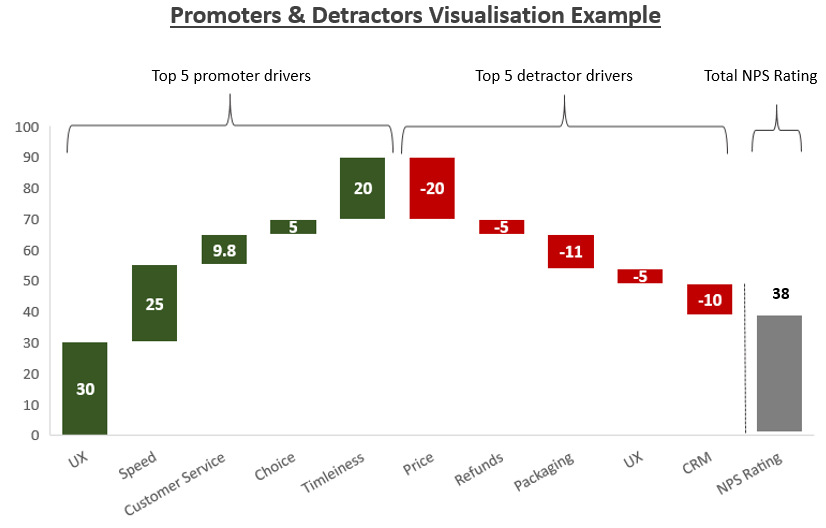Net Promoter Score (NPS) is a powerful tool for product and marketing teams. Leveraging NPS helps you (A) get closer to customers, (B) benchmark your business against the competition and (C) understand how your products are perceived - including deficiencies in the current setup.
NPS should be another metric that businesses leverage for information and as with most data sources, there are pros and cons. NPS insights help create an action plan to address product issues, which fuel product growth and over time, reduce your marketing costs (CAC). As with other data sources, we may have small sample sizes from NPS, and so we should use insights as a trigger to investigate further instead as a single source of truth.
In this post, I'll detail how NPS can be used operationally to make critical decisions for product marketers and product teams alike.
What is NPS?
NPS was created by the consultancy firm Bain & Company back in 2003 so they could better understand how to determine engagement and loyalty of customers.
“Net Promoter Score, or NPS, measures customer experience and predicts business growth. This proven metric transformed the business world and now provides the core measurement for customer experience management programs the world round.” - netpromoter.com
How is it calculated?
*Calculate your NPS using the answer to a key question, using a 0-10 scale: How likely is it that you would recommend [brand] to a friend or colleague?
*Source: netpromoter.com
Respondents are grouped as follows:
- Promoters (score 9-10) are loyal enthusiasts who will keep buying and referring others, fuelling growth.
- Passives (score 7-8) are satisfied but unenthusiastic customers who are vulnerable to competitive offerings.
- Detractors (score 0-6) are unhappy customers who can damage your brand and impede growth through negative word-of-mouth.
Subtracting the percentage of Detractors from the percentage of Promoters yields the Net Promoter Score, which can range from a low of -100 (if every customer is a Detractor) to a high of 100 (if every customer is a Promoter).”

There are two types of ways to measure NPS, (transactional) tNPS and (relational) rNPS.
rNPS: A generic approach to capture how your brand is perceived more broadly. This provides a benchmark to compare against external NPS ratings from competitors.
tNPS: Customer feedback at a granular level, including how they interact with each stage of the journey (e.g. onboarding, checkout). If implemented correctly you can identify actionable insights that can lead to creating GTM campaigns and suggesting product refinements. As you drill into certain issues, the sample size may drop significantly, but they should be used in context to what you are trying to understand.
Why should you care?
Without incorporating a consistent attitudinal metric you will only see half the performance picture. Many organizations largely focus on transactional and to a lesser degree (relative) behavioral and to an even lesser degree attitudinal data points. It is important to focus and understand all three. However, it is also quite common for attitudinal triggers to be ignored because the transactional and behavioral data is a lot quicker and easier to collect, and validate.
When someone uses your service you can track a multitude of different metrics practically in real-time (i.e. revenue, profit, time of order etc.) but I believe what’s missing is having the attitudinal data overlaid on top to complete the performance narrative. The primary reason for this is that organisations have not set up a pipeline to have a regular pulse on NPS. Also, the data sometimes comes in every 2-3 months, has a low sample size, hasn’t been implemented properly, or they don’t know what to do with it!
From some of my conversations with young startups about this topic, they have informed me that they see NPS as their Northstar metric to track growth and have respectively set up the data pipelines to review this data on a weekly basis! enabling them to track what customers are feeling/saying, and addressing problems quickly.
How product marketers can make decisions with NPS data
Understanding the nuances of the NPS data will allow you to represent the customer in any room, which is a critical role that Product Marketers play. It’s crucial to understand the voice of the customer and to drown out the noise to tactfully derive actionable insights that improve the overall customer experience.
Here's how I recommend product marketers use NPS data.
Contextualise the data
Leverage the data to tease out NPS by key segment groups (i.e. young professionals). The last thing you want to look at is an aggregated view overloaded with low-quality users. Ensure you look at segments who have a higher frequency, recency and monetary value. This is your core! This will help you identify the key pain points and allow you to laser focus on the main problems.
VOC
Voice of the customer is a regular phrase called out in most PMM job descriptions and there are many ways to collect this, be it working with research, speaking to a customer directly, social data extraction and leveraging sentiment feedback from NPS. Call out the common statements as to why promoters and detractors feel the way they do and use this as a basis of narrowing down which customers you should speak to. This will ultimately help you devise GTM programs to meet their needs.
Visualise the data
It’s important not to just look at a single score. Create a waterfall chart (see fig 1.0) that highlights the key drivers for the promoter and detractor scores that add up to the respective week/month tNPS rating. This will help you pinpoint the smallest and biggest detractor issues allowing you to create clear recommendations on what to do.
Check if Word of Mouth (WOM) is working
Correlate audiences who have been recommended by someone to buy your product with the audiences (promoters) who said they would recommend people. This will enable you to quickly see if promoters are doing what they said they would do allowing you to isolate the potential WOM impact (correlation not causal).
Go Deeper
Experiment with the data, try to calculate what 1 additional NPS point translates to in engagement/revenue, and work out what the path of least resistance is to achieve that 1 pt.
Sample Size
If your sample size is low, don’t dismiss the data, use it as a steer to further investigate the issue/theme. Work with your data partners and research teams to validate it. Additionally, if the sample size is an issue, stretch out your analysis period to 3 months (if you have to) by that point you could have enough sample size to validate your assertions and convince the naysayers.
Employee betas
I leveraged the NPS metric for an employee beta I ran for a product across 3 markets (B2B+B2C), and it massively helped the product team refine the product experience, setting it up for success for the global launch (11 markets). The engineers will make mistakes and product managers will miss things, it is at this point where product marketers can intercept and add the all-important tangible customer feedback to add value. I recall 300 bugs being captured and squished as a result of capturing NPS feedback from just employees! Think about incorporating a similar setup for your next launch as this was a driving force for the organisation to use the NPS measure more.
The immediate impact of leveraging NPS data for a Product Marketer is the context and color it adds when evaluating business performance. It illuminates the data more engagingly.

Want to learn more?
Needing to measure your product marketing success is a huge part of the role. After all, how are you going to identify what works and what doesn’t without metrics and data to back it up?
Our Metrics Certified: Masters course will give you the knowledge and confidence you need to measure the impact of your work and continue driving, not just your product and department, but the entire company towards success.
By the end of this course, you’ll be able to:
🎆 Use formulas to correctly measure key metrics.
💪 Identify which metrics you should track for each deliverable.
👀 Understand how your work can positively influence these metrics.
🔦 Relate your KPIs to your OKRs and confidently report on the impact your function has on the business.
Ready to get started?

